When I opened the doors to One Little Seed back in 2019, I knew it needed to be something different. To offer something new. And that ‘something’ couldn’t be a shiny thing or a fad.
What was obvious was that there was a need in the IT industry for experienced, passionate about technology and multi-skilled marketing manager services. But what was equally apparent was that these talented people (we call them unicorns) were not only in short supply but quickly snaffled by the mega-companies when they came on the market. Which left many equally ambitious and talented smaller businesses with big dreams, but too few resources to “make it so.” And, of course, not everyone needs a full-time marketing resource.
In retrospect, offering MMaaS (Marketing Manager as a Service) is a natural evolutionary (but innovative) step in an industry that understands and loves the concept of ‘as a Service.’ Given the industry familiarity with *aaS, our MMaaS hasn’t been a hard sell.
Five years down the track, and the decision to stick to our MMaaS guns has paid off. We don’t do one-off campaigns. We do invest in long-term relationships (not short-term dating). And we live and breathe our customers’ dreams right alongside them. As a result, we’re always busy.
We’ve got a reputation we’re proud of and can pick and choose who we work with. That may sound a little arrogant, but we’ve always insisted on only engaging with businesses where we like and respect the people we work with – and we’ve stuck to it.
If you’re reading this blog because you’re tired of trying to find an agency that speaks your language, delivers outcomes you think are valuable, and offers you the skills you need, then you’re probably pretty interested in why MMaaS works a treat.
So, here goes.
We know what you’re talking about.
The reality is that not all marketing managers are created equal. They don’t all speak, live, dream, and breathe tech, or understand the acronyms and concepts that are integral to the industry. And you don’t want to risk your business and compromise by hiring a new-to-the-IT market grad or trying to transition someone who has worked in fast-moving consumer goods or travel.
By comparison, all our marketing team are from the IT industry. So, you don’t need to dumb down how you communicate with us or spend time (and money) getting us up to speed.
You get fresh outside-the-square thinking.
Our marketing managers are often more objective as they are external to your business.
While they love you to bits and understand your business vision and hurdles, they also retain that wider perspective of the technology market and its opportunities. They’ll tell you if you’re going off course or missing the mark because they’re invested in you.
Our MMaaS team is made up of genuinely nice people.
While not pushovers by any means, our ready-seasoned technology marketing managers are exactly the sort of people you’d hire for yourself. They’re smart, strategic, accountable, grounded and yet creative team players. They’re also great communicators and contributors, so they’re a pleasure to work with. This is why our customers frequently invite us to attend industry awards events with them (we scrub up well, too).
MMaaS makes marketing more affordable.
While you know you need marketing help, if you’re not at the stage where you need (or can afford) a full-time senior, it’s hard to know what to do next. With MMaaS, we offer a range of packages which start at 6 hours a week. So, as you grow, you can scale up your marketing commitment.
You can take the pressure off your own marketing team.
Perhaps you’ve got an internal marketing team, but they’re struggling to cope with an overflow of projects (or tackle that left-of-field work that will distract them from their BAU). Or maybe you don’t have a local presence and know that you need to speak the lingo to succeed in this market. So, you need a marketing manager who will merge right in and hit the ground running with your regional customers and vendors—with no downtime.
You get a range of specialist skills onboard, not just one person.
MMaaS is holistic.
When you engage one of our marketing managers, they don’t come alone – it’s a package deal! Part of this package is their access to our in-house strategic and creative team who represent a broad set of marketing experience developed across different brands and requirements.
We’re big on accountability.
Your OLS marketing manager is charged with ‘getting things done.’
We have rigorous and transparent review and reporting processes to make sure we’re delivering what you need and expect. And if we think you’re getting a bit overkeen on spending your budget on low-return, non-strategic or off-target marketing, we will rein you in. Nicely, but firmly.
Mad about MMaaS yet?
Like you, we’re technology specialists. We’re thinkers and doers. And we thrive on helping our customers make their mark with MMaaS.
About a month ago, I attended a LinkedIn Live to listen to the latest that Jay McBain from Canalys had to say. I started taking notes for my team, and in the end, couldn't scribble fast enough and told them all to take the 29 minutes themselves to listen.
As I've percolated on this session and the insights Jay shared, it only reinforced what we've been telling our clients (and potential clients) for a while.
Being a 'trusted advisor' isn't a unique selling proposition
Trusted advisor is a phrase our industry loves. Another one is 'single throat to choke'. And I admit, six years ago, I was guilty of totting out the line whilst in vendor land. Who wouldn't want one vendor who could do it all? These days a customer has SEVEN partners that they trust.
We're seeing the landscape shift towards supporting this market dynamic with partners specialising in specific technologies and even subsets of technology.
What does this mean for you if you're one of the seven? It means that your value proposition needs to be exceptionally strong. It means that you can be more easily held to account as there's likely another partner plugging into your stack for their service delivery. If you're not delivering, they're going to point it out.
You also need to be adding more value to your relationships.
Why a content strategy and well-designed website are key
Recently we touched on Gartners B2B buying cycle. Canalys takes this even further when they delve into the 28 unique moments prior to vendor selection. Tellingly, 24 of these moments involve the partner. More often than not, our conversations with partners start with addressing their foundations.
- What is your unique value proposition?
- What is your clients' website experience?
- Development of your content strategy
The B2B buying cycle strongly mimics the B2C cycle now in terms of online experience. Are you adding value to your relationships through content? Are you providing information that helps them at the right time?
Without these foundations firmly in place, there is a multitude of relationships that will not be successful. Our relationship with you as your marketing partner, your potential relationship with a new customer, and the ongoing relationship with your existing customers.
I'm not going to sugarcoat it. To see an ROI on marketing investment when we build these foundations, it's 9-12 months. Sure, there might be some quick wins and bluebirds. But it's as everyone has heard me say, 'there's not a silver tap, and if there were, I'd be drinking pina coladas in the Bahamas'.
The customer experience (CX) starts online these days. It's like getting dressed for that crucial meeting in the morning. First impressions count. People will race through your site, looking for that essential information. They'll move on to the next potential partner if they can't find it easily. Think about customer use cases or stories. What business issue does your solution solve? What trends do you see in the market? Tell a story succinctly.
Quarterly MDF is not always your friend
Vendors are now looking towards their partners more for demand generation. However, they're expecting short-term results, which, as the digital space becomes saturated (and more expensive), presents a challenge to the partner to show these results.
Coming back to Canalys' statistic of 28 unique moments, there isn't a quality way to deliver these (and SQL) within three months.
I'd love to see a vendor take a long-term approach to partner investment rather than looking at who's making the biggest promises every quarter. I've seen one vendor give this a good nudge and commit to a six-month plan with a few partners, and it's delivered 40% growth year on year for that vendor for two years in a row with a partner we've engaged with.
The requirement for customer touch trackers is the default standard for measurement when it comes to vendor MDF. When you look at the stats around the gating of content – the numbers are stark
- 47% will never give up their details or give false details
- 23% will try to find the content elsewhere and only give up their details if they can't find it (I'm guilty of this)
- 30% will give their details if the content is valuable enough
So this begs the question – what's more important, 100% of people can read your content and progress through the funnel? Or capturing 30% of total names?
This meme made its way into our internal group chat, showing which side of the fence we sit on.

How about just measuring partner growth year on year as a metric? We've got one client whose dwell time on site is five minutes. That's amazing! But to a vendor, it doesn't tick their box for success.
Retention is often overlooked.
Another vendor metric is net new logos. However, it's widely known that the cost to retain is 5 – 25x LESS than acquisition. I get it. Everybody is chasing growth. Meaning your competitors are chasing your clients for their growth. You can build revenue from within your client base through cross-selling and referrals. Word of mouth is still a fantastic tool. If you look after your existing clients well, they'll share your name with their network. This is demonstrated with executive roundtables being an activity that delivers results – hearing where your peers are succeeding and learning from their lessons is invaluable.
How do you add more value to your existing client base? As experts in our fields, we're always reading content. We're upskilling ourselves. Share that knowledge, whether that's a personal email, to a client you know would be interested in an article. Introduce like-minded leaders to each other, aka someone who has potentially addressed a problem another one is facing. Don't look at this through the lens of what will benefit you. Look at what will be valuable to your client in general terms.
What's the single message here?
Give something for nothing. Don't become that person that only calls when they want something.
Some of the most successful advertising campaigns of all time in the B2C space have pushed the boundaries of what is safe or mainstream. Whether they loved or hated it, there wouldn’t be many people out there who aren’t familiar with Nike’s “Believe in Something” ad. It featured controversial NFL player Colin Kaepernick, who had been hitting the headlines for refusing to stand for the National Anthem to protest racial injustice.
When executed well, it sticks in people’s heads and creates a whole lot of conversation. Think the #LikeAGirl campaign from Always, Gillette’s #TheBestMenCanBe and when KFC turned a chicken shortage into a swing of positive sentiment with their KFC FCK campaign.
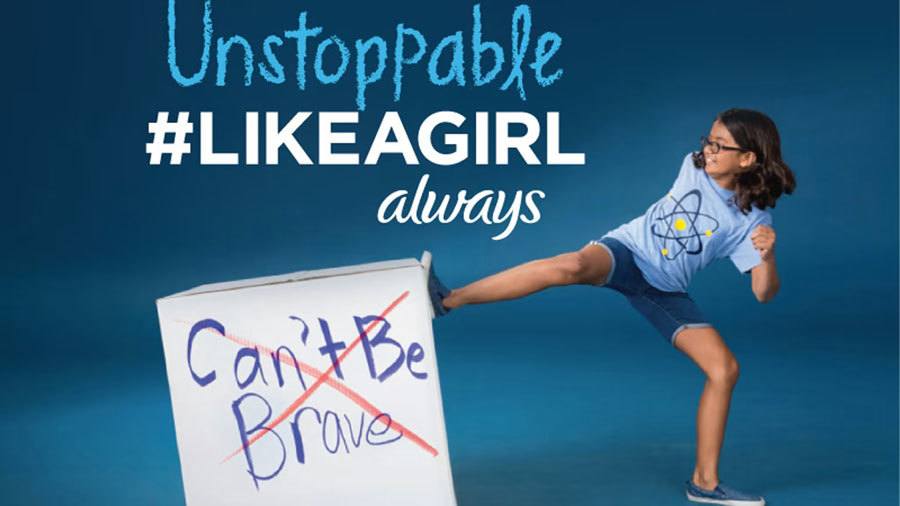
When executed poorly, a controversial approach can seriously damage sales, not to mention your brand. Like using kids to promote S&M-inspired accessories. Or when Bloomingdale used the tagline “Spike your best friend’s eggnog when they’re not looking,” and Dove’s Real Beauty campaign that showed a black woman removing her t-shirt to become a white woman (nope, not even joking – someone signed off that creative).
But what about B2B – do businesses need to play it safe, or can they come in swinging like Miley Cyrus on a proverbial wrecking ball?
Tipping your toe into the provocative waters
In my experience, big B2B enterprises tend to err on the side of caution. Of course, like any rule, there are exceptions, but overall, edgy campaigns are more common in start-up land or SMB, where risk-taking is inbuilt into their DNA, and there is less decision-by-committee.
If your brand voice lends itself to a cheeky take on things and you are keen to experiment, one safe option to explore is within email subject lines. We all get a deluge of emails daily, so an eye-catching subject line can work wonders for your open rates. Some examples;
- Your new office romance – you might be talking about a new software product, but the titillating wording alludes to something readers want to know more about
- Overcoming the [insert brand name] curse – while many companies shy away from using negative language in conjunction with their brand name, by acknowledging the challenges associated with a product or service and demonstrating how to turn it around and make it work for you, you gain your audience’s trust and respect
- Digital advertising doesn’t work – controversial statements draw the audience in to find out more
- You aren’t invited – here, the unexpected prompts curiousity
If you get a good response, you might start looking at a more provocative campaign tagline. My son’s school has a policy that I feel applies here. Ask yourself, will this hurt me? Will it hurt others? Will it hurt nature?
The general idea is to stop and sense-check the idea to make sure you aren’t putting down another company’s business, being sexist, racist, agist, or generally offensive in a way that is likely to hurt your business. This step is also where knowing your customers is vital.
Bold B2B campaign examples
A couple of examples come to mind where B2B companies have pulled it off with aplomb. However, I could think of far fewer in the B2B space than in the B2C space (and I would love to hear more that come to mind for you).
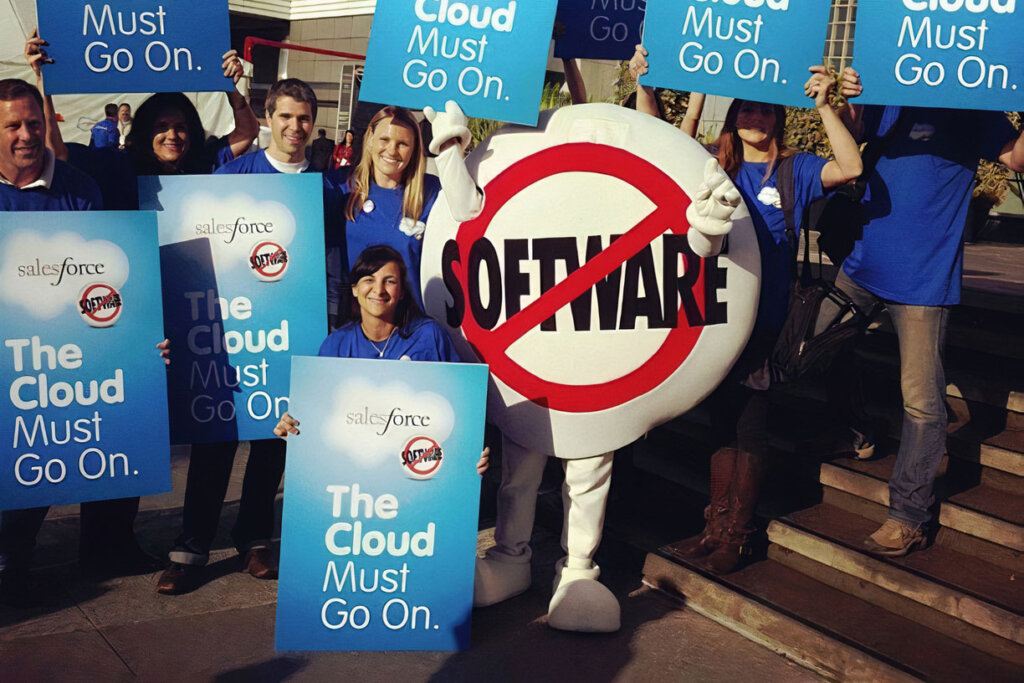
Salesforce – The End of Software campaign
Salesforce, as a company, was established around the belief that enterprise software is no longer relevant, with Software as a Service taking over as the best option for businesses. So when they launched in Feb 2000, they drew a lot of attention with their "The End of Software” campaign. It was designed to catch people’s eye in a competitive market and draw them in to discover more. They went all out, too, staging a mock protest and gaining loads of publicity.
Of course, one isolated campaign wouldn’t win them market share, but it got them noticed. Plus, it aligned with their brand voice; honest, fun, friendly, plainspoken and light-hearted.
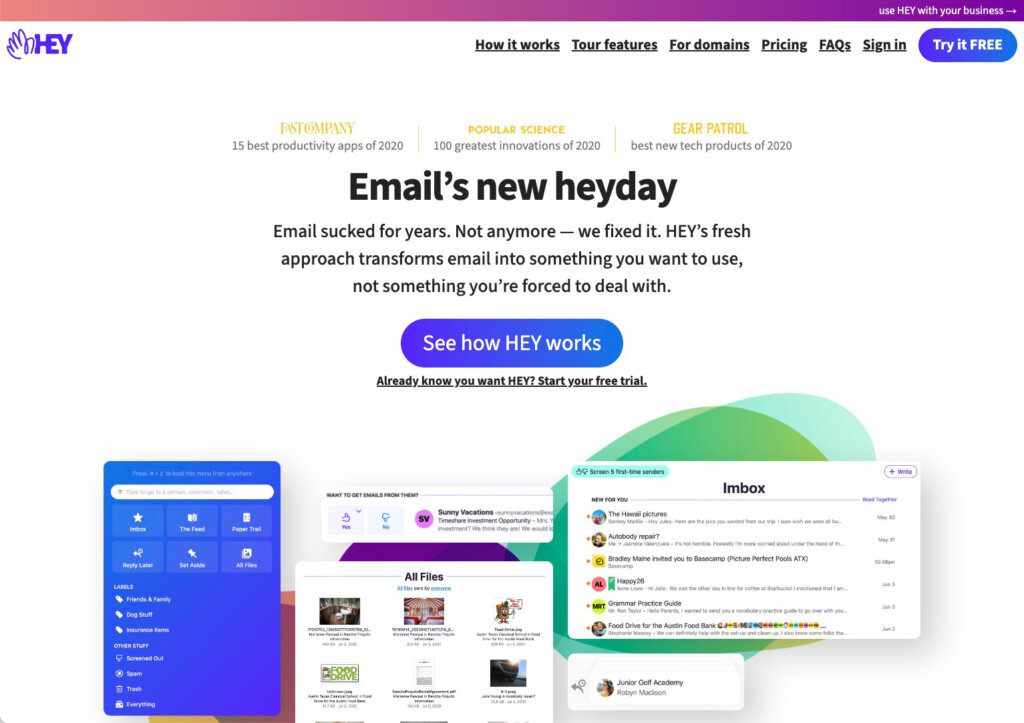
Hey – Email sucked for years. Not anymore – we fixed it
The second campaign that comes to mind takes a similar approach – Hey made a bold statement about fixing email. It worked so well because they positioned themselves apart in a crowded market, and rather than attacking their competitors, they spoke directly to consumer frustrations around email privacy and tracking. Their product genuinely IS different from the others, and they took a bold approach to shout it to the rooftops.
As always, all your communication should align with your brand. So, if your brand is conservative, safe and subdued, a provocative tagline might not be for you. Even here at One Little Seed, our HR person vetoed us publishing a job ad highlighting our “no dickheads policy.” But if your brand voice allows it, a little provocative edge can go a long way when well-executed. Just steer clear of combining kids with chains and collars.
As it seems these days, my path down a rabbit hole begins with someone else's innocuous LinkedIn post. Essentially the premise was that Thomas could have purchased a Tesla without ever having stepped inside a showroom and used Apple Pay to complete a digital transaction fully. The related article talked about the need for fully immersive experiences that allowed buyers to experience the features of the car. And if done properly, there didn't have to be any human interaction in what historically has been a human-intensive process. Side note – the ability to pay for a Tesla with Apple Pay. Mind-blowing.
We've spoken a lot internally recently about Gen Z decision makers rapidly entering our ecosystem. The Sydney Morning Herald recently published an article stating that the phone call is relegated to 'boomers'. These decision-makers are looking to complete their buying cycle without ever talking to a real person. The phone call is seen as being intrusive. The impact on the traditional SDR/BDR model here is enormous.
This raises the challenge that marketers and salespeople have relied upon for years, the personal and human connection.
It's irrefutable that the B2B buying journey has changed. And COVID, like it or not, has changed it immensely.
How do you establish relationships when you've never met a person?
The focus shifts from that in-person relationship to the emotive response your content builds. The lightbulb moment when the buyer goes, yes, this is what I need. Or, that was useful. I'll keep that link. It's about being constantly present across your channels.
In our recent blog post on Changing buyer priorities, we touched on the increase in the buying group size. That for 62% of businesses, it's now four to nine people. When you're targeting a buying group, that research and validation process is no longer linear. It's not about one person consuming your content in the order you planned for them.
Gartner recently published the 'New B2B Buying Journey and its Implication for Sales' and called out some interesting statistics. When B2B buyers assess multiple options, they only spend 5-6% of the cycle meeting with the relevant suppliers.
This reinforces our statement that they've done their due diligence by the time the buyer has reached out to you, and you're most likely on the shortlist. Every consumer or B2B buyer understands the value of their contact details. Nobody wants to be spammed. Nobody wants to be called ten minutes after downloading a white paper. They want time to digest the information you've made freely available to them. Because if you've not made it freely available, someone else most likely has.
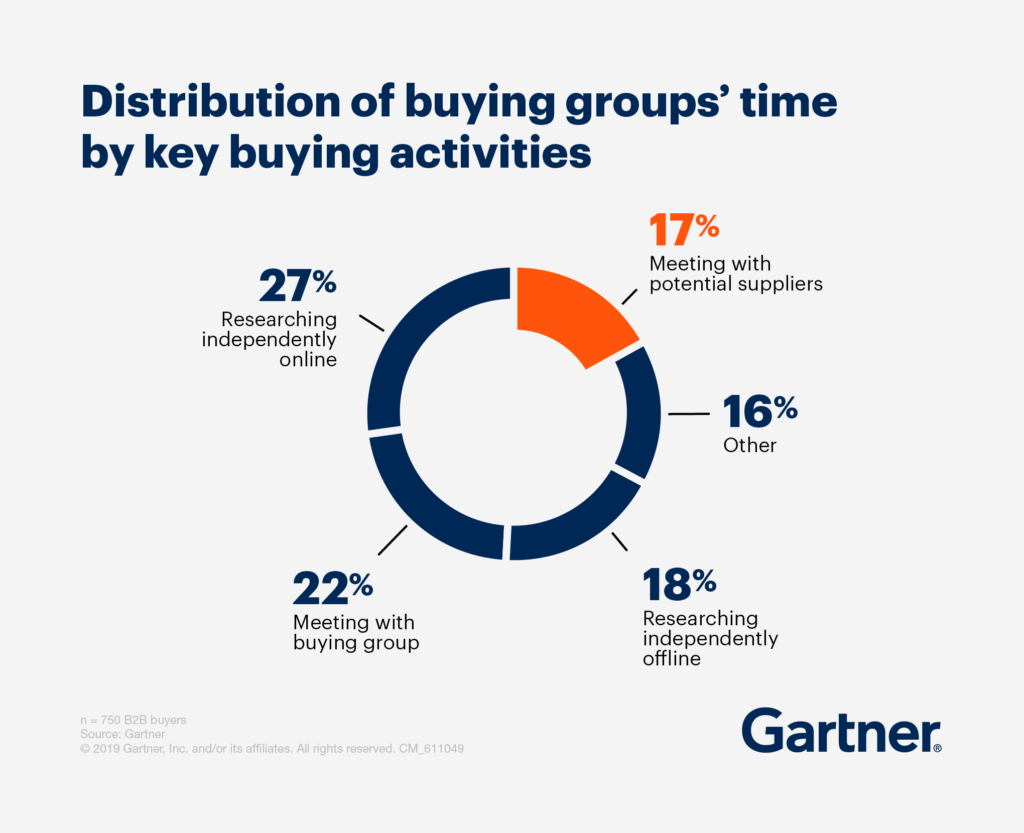
It's irrefutable that the B2B buying journey has changed. And COVID, like it or not, has changed it immensely. In many ways, the B2B buying cycle now partially reflects B2C in terms of information gathering. You need to create a digital experience. You need to be easily accessible digitally. Half the challenge is about being easy to find in a complex and crowded landscape.
It's also about taking your navel gazing lens off. It's about offering value and knowledge to your customers in return for what feels like potentially nothing for a long time. Why is this important?
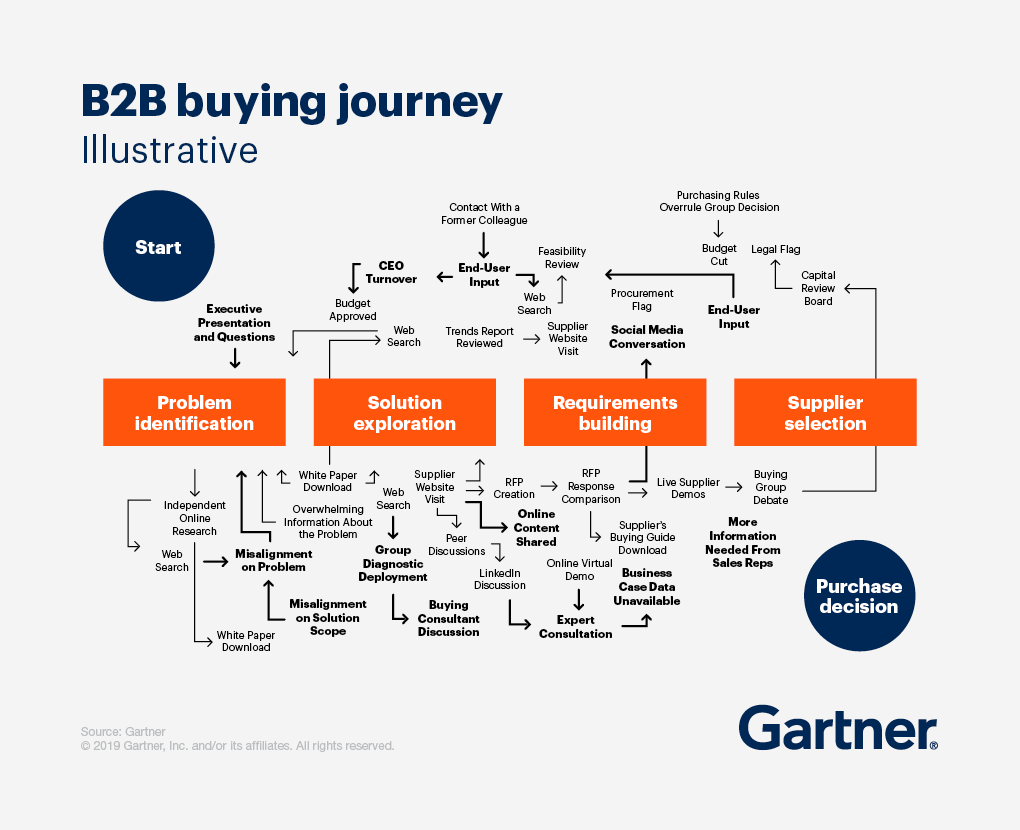
Because of this (above). It's by no means the most common buying cycle, but we can all relate to different steps across this cycle. This illustrative buying process shows 12 online touchpoints, from web searches to white paper downloads. We also know that B2B buyers still heavily lean into LinkedIn for peer reviews and feedback. However, beware of jumping into a discussion stream with a cold pitch.
Every content piece doesn't need to be tied back to your product or solution. More often than not, buyers want to know that you understand their industry. That you understand the challenges their business faces. It also caters to the different lens through which each of your buying decision makers is looking at this issue. With the large-scale investment we are often dealing with within this industry, there are conflicting internal priorities and understanding of the issue. It still comes back to the simple premise of building trust with your buyers.
How do you make a complex buying decision easier?
By providing the right content at the right time. What is the right time? When your buyer is searching for it. Whether that's 9pm on the couch on their phone or 2pm at their desk. Gartner states that for those buyers, that information was helpful; it made the buying process 2.8 times easier. Easier means faster movement through the funnel.
So, what does this really all mean?
- You can't necessarily measure your funnel height by the type of content consumed
- Prospective buyers aren't going to follow the path you think they will (or you plan for them)
- Ensure your content addresses business issues. What problem is this going to fix? How is it going to fix it?
- Build your content to make sense in stand-alone fashion, or reference previous materials within the content for context
And what I believe to be the most important point.
Accessibility is key. This is about them. Not about you.
Everyone is talking about the great resignation, skills shortage and now the boomerang employee. I kind of fit into the category myself. After many years working in the Channel focusing on marketing & events, I changed careers. I chose to work for a big global bank- so different! After about 7 years I have returned to the industry. It’s been great to connect again with familiar faces and get back to what I truly love doing. I am learning what has and has not changed and how to speak the language again. I forgot how many acronyms there are!
When returning to an industry you have previously worked in some things are like riding a bike, you put your foot on the peddles and off you go. That is the value of experience, a lot of information comes flowing back to you but not everything. Some things you need to learn again from scratch. Which brings up the question, can you ever conquer every channel marketing acronym or is it a constant learning curve? I believe it’s the latter. In my first week back, I started an acronym spreadsheet. I opened it during meetings and calls and was surprised how quickly it was filling up. I had over 20 entries by day 5. It was clear, there was a lot of lingo to learn.
My little glossary is constantly growing and it’s a tool I find very useful. This got me thinking. With the current skills shortage there are people coming into the industry that have never worked in it before. What might seem obvious to some people might be marketing mumbo jumbo to others.
So, if like me you are returning to the industry or even better if you are new to it here are some acronyms you might find useful. Soon you will be using them effortlessly and look like a pro.
| Acronym | Stands for: |
|---|---|
| aaS | as a Service |
| ABM | Account-Based Marketing |
| ABX | Account Based Experience |
| AMSV | Average Monthly Search Volume |
| API | Application Programming Interface |
| CAM | Channel Account Manager |
| CDP | Continuous Data Protection |
| CRO | Conversion Rate Optimisation |
| CtOR | Click-to-Open Rate |
| DC | Data Centre |
| DRaaS | Disaster Recovery as a Service |
| DTX | Digital Transformation |
| EAM | Enterprise Account Manager |
| EBC | Executive Briefing Centre |
| GMB | Google My Business |
| IDR | Intrusion Detection and Response |
| ISV | Independent Software Vendors |
| L2RM | Lead to Revenue Management |
| MDF | Market Development Funds |
| MDR | Managed Detection and Response |
| MMaaS | Marketing Manager as a Service |
| NAM | Named Account Manager |
| PAM | Partner Account Manager |
| PII | Personally Identifiable Information |
| PMMS | Partner Marketing Manager as a service |
| PoP | Proof of Performance |
| PPC | Pay-Per-Click |
| PRM | Partner Relationship Management |
| RoAS | Return on Ad Spend |
| RSM | Regional Sales Manager |
| SI | Systems Integration |
| SKO | Sales Kick Off |
| STaaS | Storage as a Service |
| TAM | Territory Account Manager |
| TL;DR | Too Long Didn’t Read |
| USP | Unique Selling Proposition |
| VAR | Value-Added Reseller |
| YT | YouTube |